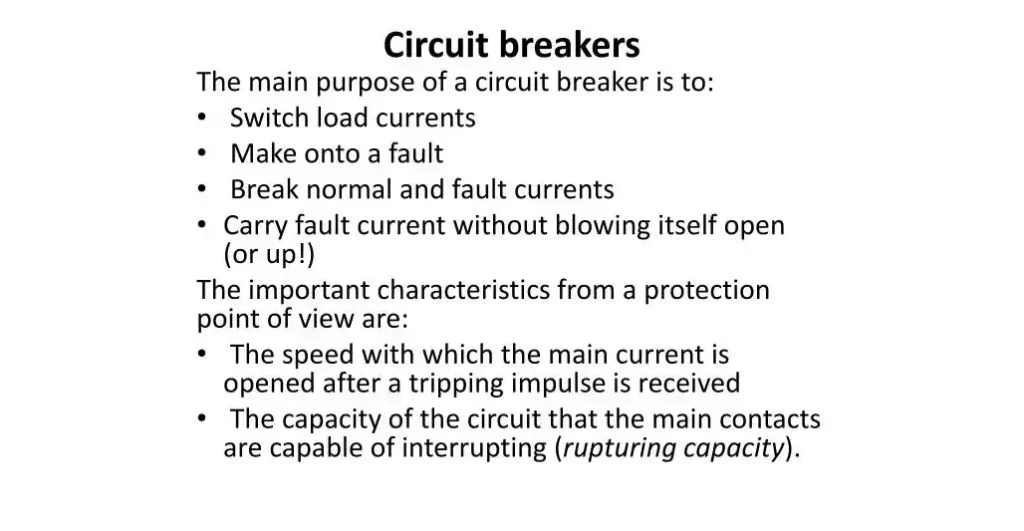In the realm of electrical systems, circuit breakers play a crucial role in safeguarding our homes and workplaces from electrical hazards. Understanding standard circuit breaker sizes is essential for ensuring the safety and efficiency of your electrical setup.
This article will delve into the various aspects of circuit breakers, from their types and classifications to their applications and future prospects.
Importance of Circuit Breakers

Circuit breakers are essential components in electrical systems, serving as critical safety devices that protect electrical circuits from damage caused by overcurrent, short circuits, and electrical faults. Here’s a closer look at why circuit breakers are so important:
1. Protection Against Electrical Overloads
Electrical circuits are designed to handle a specific amount of current. When too many appliances or devices are connected to a circuit, the current can exceed the safe limit, causing an overload. Circuit breakers protect against these overloads by interrupting the flow of electricity, preventing potential damage to wiring and electrical devices.
2. Prevention of Electrical Fires
One of the most significant risks of electrical faults is the possibility of an electrical fire. Overloaded circuits or short circuits can cause wiring to overheat, potentially igniting surrounding materials. Circuit breakers help mitigate this risk by cutting off the electrical supply when an abnormal condition is detected, thus preventing overheating and reducing the likelihood of fires.
3. Safeguarding Human Lives
Circuit breakers play a vital role in protecting people from electrical hazards. Ground Fault Circuit Interrupters (GFCIs), a type of circuit breaker, are specifically designed to protect against electric shock. They detect ground faults and interrupt the circuit before the current can cause serious harm to individuals.
4. Ensuring the Reliability of Electrical Systems
By protecting circuits from damage, circuit breakers ensure the reliability and longevity of electrical systems. Regularly tripping breakers indicate potential issues in the electrical system that need to be addressed, allowing for timely maintenance and preventing more serious problems.
5. Compliance with Electrical Safety Standards
Adhering to electrical safety standards and building codes is crucial for any residential, commercial, or industrial property. Properly sized and functioning circuit breakers are required by these standards to ensure the safety of electrical installations. Compliance helps avoid legal issues and ensures the property is safe for occupants.
6. Cost Savings
Preventing damage to electrical systems and appliances through the use of circuit breakers can result in significant cost savings. Repairs and replacements for electrical equipment damaged by overloads or short circuits can be expensive. Circuit breakers act as a safeguard, reducing the likelihood of costly electrical damage.
7. Versatility in Applications
Circuit breakers come in various types and sizes, suitable for a wide range of applications from residential homes to large industrial facilities. This versatility ensures that there is an appropriate circuit breaker for every type of electrical setup, providing tailored protection based on specific needs.
8. Enhancing System Efficiency
By ensuring that electrical systems operate within their designed limits, circuit breakers enhance overall system efficiency. They prevent the inefficiencies and potential hazards associated with overloaded or faulty circuits, contributing to the smooth and effective operation of electrical systems.
Types of Circuit Breaker

Circuit breakers come in various types and categories, each designed for specific applications and environments.
Residential Circuit Breakers
- Standard Breakers: These are the most common type of circuit breakers found in residential properties. They come in different sizes ranging from 15 to 50 amps and are typically used for general-purpose circuits.
- AFCI Breakers: Arc Fault Circuit Interrupters (AFCIs) are designed to detect and mitigate the risk of electrical fires caused by arcing faults in wiring.
- GFCI Breakers: Ground Fault Circuit Interrupters (GFCIs) are essential for areas where water is present, such as kitchens, bathrooms, and outdoor outlets, as they protect against electric shock.
Commercial and Industrial Circuit Breakers
- Molded Case Circuit Breakers (MCCBs): These are commonly used in commercial and industrial settings for higher current ratings and increased protection against overloads and short circuits.
- Miniature Circuit Breakers (MCBs): Similar to residential circuit breakers but with higher current ratings, MCBs are widely used in commercial and industrial applications.
- High-Voltage Circuit Breakers: These specialized circuit breakers are designed to handle high voltages and currents typically found in industrial power distribution systems.
How to Size a Circuit Breaker
Circuit Breaker Size Chart
A circuit breaker size chart is a crucial tool for electricians, engineers, and DIY enthusiasts when selecting the appropriate circuit breaker for a particular electrical circuit. The size of a circuit breaker is determined by the electrical load it needs to protect, which is measured in amperes (amps). Properly sizing a circuit breaker ensures the safety and efficiency of an electrical system. Here’s a detailed explanation of the circuit breaker size chart and its components:
1. Ampere Rating
The ampere rating, or amperage, is the most critical factor in determining the size of a circuit breaker. It represents the maximum amount of electrical current the breaker can handle before tripping. Standard residential circuit breakers typically come in sizes of 15, 20, 30, 40, and 50 amps.
Common Amp Ratings and Their Uses:
- 15 Amp Breakers: Typically used for general lighting circuits and outlets.
- 20 Amp Breakers: Commonly used for kitchen appliances, small air conditioners, and larger lighting circuits.
- 30 Amp Breakers: Used for water heaters, central air conditioners, and electric dryers.
- 40 Amp Breakers: Suitable for electric ranges and ovens.
- 50 Amp Breakers: Often used for large appliances and subpanels.
2. Voltage Rating
Circuit breakers are also rated by voltage, which must match the system they are protecting. Common voltage ratings include:
- 120/240V: Standard for most residential applications.
- 240V: Used for higher power appliances and equipment.
- 480V: Common in industrial settings.
3. Interrupting Capacity
The interrupting capacity, measured in kiloamperes (kA), indicates the maximum fault current a circuit breaker can safely interrupt without damage. This rating is critical in commercial and industrial applications where high fault currents can occur.
4 Wire Gauge and Circuit Breaker Size
The size of the wire (gauge) used in a circuit must be compatible with the circuit breaker’s amperage rating. Using the wrong wire gauge can lead to overheating and potential fire hazards. The chart typically specifies the appropriate wire gauge for each breaker size.
Wire Gauge and Amp Ratings:
- 14 AWG (American Wire Gauge): Suitable for 15-amp circuits.
- 12 AWG: Suitable for 20-amp circuits.
- 10 AWG: Suitable for 30-amp circuits.
- 8 AWG: Suitable for 40-amp circuits.
- 6 AWG: Suitable for 50-amp circuits.
5 Application and Environment
The circuit breaker size chart may also provide guidance based on the specific application and environmental factors, such as:
- Indoor vs. Outdoor: Different breakers may be rated for indoor or outdoor use.
- Temperature Ratings: Certain environments may require breakers with specific temperature ratings to ensure reliable operation.
Example of a Circuit Breaker Size Chart
| Amp Rating | Wire Gauge | Typical Applications |
|---|---|---|
| 15 Amps | 14 AWG | General lighting, outlets |
| 20 Amps | 12 AWG | Kitchen appliances, larger lighting |
| 30 Amps | 10 AWG | Water heaters, dryers, air conditioners |
| 40 Amps | 8 AWG | Electric ranges, ovens |
| 50 Amps | 6 AWG | Large appliances, subpanels |
Typical Circuit Breaker Sizes
Choosing the right circuit breaker size is essential for the safety and efficiency of electrical systems. Circuit breakers come in various sizes, primarily defined by their amperage ratings. Here are the typical circuit breaker sizes commonly used in residential, commercial, and industrial applications:
Residential Circuit Breaker Sizes
- 15 Amp Breakers
- Typical Uses: General lighting circuits, standard outlets
- Wire Gauge: 14 AWG
- Common Locations: Bedrooms, living rooms, and hallways
- 20 Amp Breakers
- Typical Uses: Kitchen appliances, small air conditioners, and larger lighting circuits
- Wire Gauge: 12 AWG
- Common Locations: Kitchens, bathrooms, laundry rooms
- 30 Amp Breakers
- Typical Uses: Water heaters, central air conditioners, electric dryers
- Wire Gauge: 10 AWG
- Common Locations: Utility rooms, dedicated circuits for heavy appliances
- 40 Amp Breakers
- Typical Uses: Electric ranges, ovens
- Wire Gauge: 8 AWG
- Common Locations: Kitchens, dedicated circuits for large cooking appliances
- 50 Amp Breakers
- Typical Uses: Large appliances, subpanels
- Wire Gauge: 6 AWG
- Common Locations: Garages, workshops, subpanel feeds
Commercial and Industrial Circuit Breaker Sizes
- Molded Case Circuit Breakers (MCCBs)
- Typical Uses: High current circuits in commercial buildings
- Amperage Range: 15 amps to 2500 amps
- Common Locations: Distribution panels, main service panels
- Miniature Circuit Breakers (MCBs)
- Typical Uses: Branch circuit protection
- Amperage Range: 0.5 amps to 100 amps
- Common Locations: Commercial buildings, industrial facilities
- High-Voltage Circuit Breakers
- Typical Uses: Power distribution in industrial settings
- Amperage Range: Up to 5000 amps
- Common Locations: Electrical substations, large industrial plants
Specialty Circuit Breaker Sizes
- Arc Fault Circuit Interrupters (AFCIs)
- Typical Uses: Protection against electrical fires caused by arcing faults
- Amperage Range: 15 amps to 20 amps
- Common Locations: Bedrooms, living areas, and other residential circuits
- Ground Fault Circuit Interrupters (GFCIs)
- Typical Uses: Protection against electrical shock
- Amperage Range: 15 amps to 20 amps
- Common Locations: Kitchens, bathrooms, outdoor outlets, and areas with water exposure
Voltage Ratings
In addition to amperage, circuit breakers are also rated by voltage, which must match the system they are protecting:
- 120/240V: Standard for most residential applications.
- 240V: Used for higher power appliances and equipment.
- 480V: Common in industrial settings.
Example of a Circuit Breaker Size Chart
| Amp Rating | Wire Gauge | Typical Applications |
|---|---|---|
| 15 Amps | 14 AWG | General lighting, outlets |
| 20 Amps | 12 AWG | Kitchen appliances, larger lighting |
| 30 Amps | 10 AWG | Water heaters, dryers, air conditioners |
| 40 Amps | 8 AWG | Electric ranges, ovens |
| 50 Amps | 6 AWG | Large appliances, subpanels |
Conclusion
Understanding standard circuit breaker sizes is paramount for maintaining electrical safety and reliability in residential, commercial, and industrial settings. By recognizing the symptoms of circuit breaker issues, addressing underlying causes, and implementing preventive measures, individuals and businesses can safeguard their electrical systems against potential hazards and ensure uninterrupted operation.